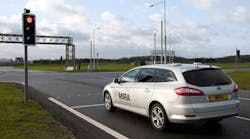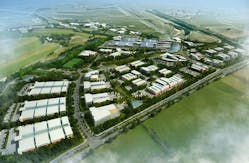The test track at MIRA sits in the middle of the English countryside, well hidden from view. Waiting for its passengers on an interior circuit is a Ford Focus; at the wheel is a research engineer. Visiting reporters get into the car and it slowly pulls away onto a circuit that includes various turns and stops. As a traffic light turns green, the car begins to accelerate and then takes a left turn on the track. Nothing is out of the ordinary except that the engineer in the driver’s seat is not touching the steering wheel or the pedals. No one is driving the car.
MIRA’s work on intelligent vehicle systems is just one part of the wide-ranging engineering and testing activities at the facility. In fact, the vision statement of MIRA is, “One day every journey in the world will be positively influenced by us.” That’s an ambitious statement, but it’s clear from a visit to MIRA’s complex in Warwickshire, England that ambition is not in short supply.
MIRA (formerly the Motor Industry Research Association) is in the midst of a 10-year development plan designed to create a state-of-the-art campus of shared research and test resources, individual research facilities for various OEMs and suppliers, and amenities such as a hotel and recreational facilities. Terry Spall, commercial director for MIRA, likens plans for the campus to a “Google of the automotive world.” Since 2009, staff at MIRA has more than doubled to 600. Plans are to have 2,000 engineers working for MIRA and various tenant companies at the site by 2021.
MIRA was founded in 1946 by the British government to provide shared R&D resources for the 100 or so automotive OEMs and suppliers operating in the United Kingdom at the time. The 850-acre site, a former RAF air base, has 62 miles of test track and is centrally located for the British automobile industry. In 1976, the government transitioned MIRA to an independent, commercial enterprise. Last year, it had sales of more than $78 million. MIRA does the majority of its business with automotive firms, but also works with defense, aerospace and rail clients.
Geoff Davis, MIRA’s chief technology officer, says the organization is developing a technology cluster that benefits transportation companies in several ways. They can take advantage of shared facilities so that they don’t have to make expensive capital investments. They can “rent” expertise from MIRA; for example, if they need an ergonomics expert for a project, they can tap MIRA’s staff for help. And by having OEMs and suppliers in close proximity, it encourages collaboration between companies.
MIRA is increasingly engaged with projects to make vehicles safer and more autonomous, Davis said. MIRA’s engineers are working on active cruise control, lane departure warning systems, and even self-driving vehicles.
MIRA staffers are involved in electric and hybrid car development, such as work on battery management systems. Research and testing activities also are growing around the software and electrical systems used to operate cars, such as steer-by-wire or throttle-by-wire, that are supplanting mechanical linkages.
Cybersecurity is another issue gaining more attention at MIRA. “As vehicles become more connected, there is an ever increasing threat that people will intercept those vehicles,” said Davis, with threats ranging from stealing bank information from a person’s mobile phone to taking control of the vehicle.
MIRA’s work with clients falls into three main areas:
Vehicle Engineering – Engineers at MIRA can help manufacturers with everything from developing a vehicle from concept to putting it into production. They work on vehicle architecture, ride and handling, noise and vibration, aerodynamics and many other issues – everything except the design and engineering of gas and diesel engines. MIRA is increasingly involved in the development of electric motors, batteries and hybrid vehicles.
Test Engineering – MIRA performs testing services for vehicle components all the way through validation of entire systems and automobiles. MIRA’s facilities include wind tunnels for testing aerodynamic features, climatic test chambers that can simulate extreme conditions such as snow or desert heat and electromagnetic capabilities testing to ensure that, for example, answering your cell phone doesn’t set off the car’s airbags. MIRA helps manufacturers meet a variety of certifications for various areas of the world.
Location – A major growth avenue for MIRA is having auto manufacturers locate at the technology park. In addition to offering multi-tenant buildings, MIRA builds discrete facilities for companies in exchange for long-term leases. Companies can use their own equipment and staff, but also take advantage of shared resources so they can keep personnel requirements lean and avoid costly capital expenditures.
For example, Haldex, the Swedish manufacturer of brake systems for commercial vehicles, is opening a 25,000-square-feet R&D center at MIRA in October. The custom building will include design and simulation facilities, a full validation laboratory with integrated electromagnetic compatibility (EMC) capabilities and a series of garage workshops to house development vehicles. Haldex is assembling a team of 100 engineers for the new center.
Bo Annvik, Haldex president and CEO, said the “facility integration will provide a unique level of interchange between our teams and will allow shorter development cycles and improve our responsiveness to market needs.”
Davis noted that MIRA was intended from the start to have competitors in close proximity working on very confidential projects. As a result, security at the site is strict, with elaborate access protocols and surveillance systems.
Mixing Close Proximity with Global Reach
MIRA’s growth in recent years mirrors recovery in the British automobile industry. In 2012, Spall noted, UK facilities manufactured 1.6 million vehicles and 2.5 million engines. Projections are that by 2017, the UK will produce 2.2 million vehicles, exceeding the production record of 1.9 million and making the country the third-largest vehicle producer in Europe. Some 81% of the vehicles were exported, accounting for 11% of total UK exports.
As UK vehicle manufacturers such as Jaguar Land Rover, Nissan and Mini grow, they are pushing their Tier 1 suppliers to locate engineering staffs nearby, noted Spall. That is one reason 30 companies – familiar names such as TRW, Dunlop, Bosch and Arvin Meritor - are already operating at MIRA and their ranks continue to grow each year.
The British government is also leading efforts to have more automotive suppliers locate manufacturing in the UK. Recently, the government found that 100 commodities used in auto production are not made in the United Kingdom. Replacing imports with domestic products presents a $5.1 billion opportunity if new suppliers can be attracted to the U.K.
While the bulk of MIRA’s work is with automobile clients, it also is growing its defense business. For example, it worked with a South Korean battery cell manufacturer on a competition sponsored by the military to design a battery pack for a hybrid unmanned vehicle. MIRA helped develop a 22-kWh battery pack from scratch in 10 months that had twice the energy density of a competing off-the-shelf product.
When the UK began military operations in Afghanistan, there was an urgent need for a detection system for IEDs. In less than a year, MIRA reengineered a Land Rover Defender with a system that can detect IEDs while the operator maneuvers the vehicle from several hundred yards away. “This product has saved lives,” noted Davis.
While MIRA is heavily identified with the UK automotive industry, the organization’s plans are global. It increasingly serves as a European location for R&D activities of automotive companies from Asia and other regions. MIRA is also building its global presence, with agents in a host of countries, including Singapore, Malaysia, Korea, Japan and Turkey, and facilities in India, China and Brazil.
“We see the need of the Chinese OEMs shifting from one where they shipped their engineering programs to European providers such as us to a position now where they are almost insisting that most of the work is done in China. So we are having to build an engineering team in China quite rapidly,” said Davis. Even with that, he added, MIRA still provides engineering expertise from the UK on some of the more complex programs and companies continue to send vehicles for road testing and validation.
So as the global automotive industry charges into a new era of bold technology changes, MIRA officials seem confident that they will play an important role in shaping and facilitating the future of transportation.




